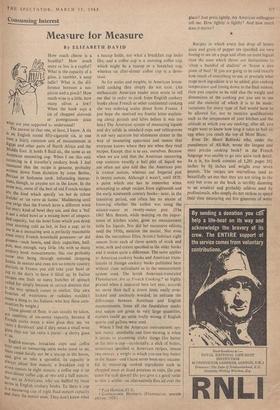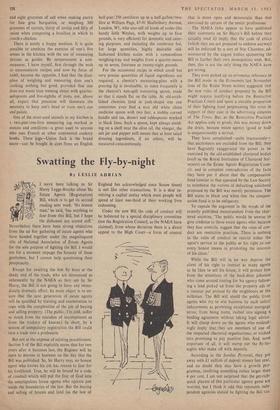Consuming Interest
Measure for Measure
By ELIZABETH DAVID The answer to that one, at least, I know. A tin 1,.! an English round fifty-cigarette tin, at one time a fairly common unit of measurement in Egypt and other parts of North Africa and the Middle East. It holds 8 fluid oz., the same as an American measuring cup. When I see this unit occurring in a. traveller's cookery book I feel reassured that the recipe is genuine, probably written down from dictation by some Berber, Persian or Sudanese cook. Infuriating instruc- tions, though, to anyone not in the know. In the same way, some of the best of old French recipes are , the kind which specify 'un bol de creme fraiche' or 'un verre de farine.' Maddening until one twigs that the French have a different word for every kind of bowl they use, and that a 'bol' is not a salad bowl or a mixing bowl of unspeci- fied capacity, but the bowl from which you drink Your morning café au lait, in fact a cup; so to use it as a measuring unit is perfectly reasonable since every French household possesses—or did Po. ssess—such bowls, and their capacities, half- Pint, near enough, vary little. (As with so many Cookery book measurements, this one probably came into being through national shopping habits. In remote and even not so remote country districts in France you still take your bowl or Jug to the dairy to have it filled up. In Italian recipes one finds so many bunches of spinach called for simply because in certain districts that is the way spinach conies to market. Our own bunches of watercress or radishes wouldn't mean a thing to the Italians, who buy these com- modities by weight.) Those glasses of flour, it can usually be taken, are tumblers of six-ounce capacity, because if French cooks mean a wine glass they say 'un verre 4 Bordeaux' and if they mean a small wine glass they say 'un verre a porto'—a sherry glass te us.
English teacups, , breakfast cups and coffee cups used as measuring units make sense to us; there could hardly not be a teacup in the house, and, give or take a spoonful, its capacity is always about five ounces; a breakfast cup is seven ounces to eight ounces; a coffee cup is an after-dinner coffee cup, or two and a half ounces; but not to Americans, who are baffled by these terms in English cookery books. To them a cup a measuring cup of eight fluid ounces capacity and there the matter ends. They don't know what a teacup holds, nor what a breakfast cup looks like, and a coffee cup is a morning coffee cup, which might be a teacup or a breakfast cup, whereas an after-dinner coffee cup is a demi- tasse.
As for scales and weights, in American house- hold cooking they simply do not exist. (An enthusiastic American reader once wrote to tell me that in order to cook from English cookery books about French or other continental cooking she was ordering scales direct from France. I just hope she received my frantic letter explain- ing about pounds and kilos before it was too late.) The American system of measuring liquids and dry solids in standard cups and tablespoons is not very accurate but eliminates clutter in the way of measuring apparatus and means that everyone knows where they are when they read recipes. Except, that is to say, ourselves. Because when we are told that the American measuring cup contains exactly a half pint of liquid we are often not also told that the American pint is sixteen ounces, whereas our Imperial pint is twenty ounces. Although it wasn't, until 1878; a point which one has to remember when attempting to adapt recipes from eighteenth and the early nineteenth century books—later, in the transition period, one often has no means of knowing whether the author was using the sixteen-ounce or twenty-ounce pint. (The 1861 Mrs. Beeton, while insisting on the impor- tance of kitchen scales, gives no measurement table for liquids. Nor did her successive editors, until the 1950s, mention the matter. Nor even does the meticulous Eliza Acton.) Subtract eight ounces from each of those quarts of stock and wine, milk and cream specified in the older books and it makes quite a difference. The same applies to American cookery books and American trans- lations of foreign cookery books published here without clear indications as to the measurement system used. The lavish American-translated Flammarion Art of French Cooking,* so highly praised when it appeared here last year, accords no more than half a dozen lines, easily over- looked and unclearly worded, to indicate the differences between American and English measurements. Since all the foundation stocks and sauces are given in very large quantities, matters could go quite badly wrong if English quarts and gallons. were used.
Where I find the American measurement sys- tem messy, unreliable and time-wasting is when it conies to cramming sticky things like butter or fat into a cup--incidentally, a stick of butter, sometimes specified in American recipes, means two ounces: a weight in which you can buy butter in the States—and I have never been very success- ful in measuring cooked ingredients such as chopped meat or diced potatoes in cups. Do you cram the stuff down? Do you give it a good rattle so that it settles—or alternatively flies all over the
* Paul Franilyn, I5
t GAS-1140NOMIE PI2ATIQUE. (Flammarion, seventh edition, 1928.) place? Just press lightly, my American colleagues tell me. How lightly is lightly? And how much does it matter?
Recipes in which every last drop of lemon juice and grain of pepper are specified are very boring to see on a page and often no more logical than the ones which throw out instructions to 'chop a handful of shallots' or 'braise a nice piece of beef.' If you are going to be told exactly how much of everything to use, at precisely what stage each ingredient is to be added, plus cooking temperature and timing down to the final minute, then you require to be told also the weight and dimensions of the cooking pot you are to use and the material of which it is to be made; variations for every type of fuel would have to be allowed for, not to mention qualifications such as the temperature of your kitchen and the altitude at which you are cooking; after all, you might want to know how long it takes to boil an egg when you reach the top of Mont Blanc.
Even Dr. Henri Babinski who, under the pseudonym of Afi-Bab, wrote the longest and most precise cooking bookt in the French language was unable to go into quite such detail. As it is, his book consists of 1,281 pages 10} inches by 81 inches and weighs over seven pounds. The recipes are marvellous (and so beautifully set out that they are not tiring to the eye) but even so the book is terribly daunting to an amateur and probably seldom used by professionals, who simply do not reckon to spend their time measuring out five grammes of water and eight grammes of salt when making pastry for foie Bras barquettes, or weighing 300 grammes of carrots, thirty of turnip and fifty of onion when composing a bouillon in which to poach a chicken.
There is surely a happy medium. It is quite possible to combine the exercise of one's five senses in the kitchen with the use of measuring devices as guides. By temperament a non- measurer, I have myself, first through the wish to communicate recipes and now by force of habit, become the opposite. I find that the disci- pline of weighing and measuring does one's cooking nothing but good, provided that one does not waste time messing about with quarter- saltspoons and five-eighths of pints, nor, above all, expect that precision will eliminate the necessity to keep one's head or train one's eye and palate.
One of the-most-used utensils in my kitchen is A two-pint/one-litre measuring jug marked in ounces and centilitres—a great asset to anyone who uses French or other continental cookery book,s. These jugs—Union Jack is the brand name—can be bought in sizes from an English half-pint/250 centilitres up to a half-gallon/two- litre at William Page, 87-91 Shaftesbury Avenue, London, WI, who also sell all kinds of scales (the handy little Weylux, with weights up to four pounds, is very efficient) for domestic and cater- ing purposes, and including the cumbrous but, for large quantities, highly desirable old- fashioned kitchen scales with a commodious weighing-tray and weights from a quarter-ounce up to seven, fourteen or twenty-eight pounds.
For the occasional recipe in which small but very precise quantities of liquid ingredients are required, a chemist's measuring-glass with a pouring lip is invaluable; so more frequently is the chemist's non-spill measuring spoon, made so that it stands flat on the table. At old-estab- lished chemists (and in junk-shops) one can sometimes even find a nice old white china medicine spoon with two feet, a stubby curved handle and tea, dessert and tablespoons marked in black lines. Such a spoon, kept always stand- ing on a shelf near the olive oil, the vinegar, the salt jar and pepper mill means that at least salad dressing ingredients, if no others, will be measured conscientiously.



































 Previous page
Previous page